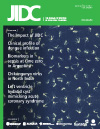Prevalence and antibiotic resistance of bacterial pathogens isolated from childhood diarrhoea in four provinces of Kenya
DOI:
https://doi.org/10.3855/jidc.2196Keywords:
antimicrobial drug resistance, enteric bacterial pathogens, E. coli, Shigella, Salmonella, Vibrio choleraAbstract
Introduction: Diarrhoea is one of the main causes of morbidity and mortality among children in sub-Saharan Africa, and one of the main causes of hospital admissions in rural areas of Kenya. In Kenya, antimicrobial resistance surveillance has been conducted only at the institutional levels, with limited sharing of information and analysis of data. As a result, the actual scale of regional or national antimicrobial drug resistance is not well defined.
Methodology: Stool samples were collected between 1 October 2007 and 30 September 2008 from a total of 651 outpatients with diarrhoea who were under five years of age in four provinces of Kenya. Conventional, biochemical methods, multiplex PCR and antimicrobial susceptibility were conducted to identify the bacterial causes and virulence factors in the isolates, respectively.
Results: Of the 651 patients screened, we identified the causes of 115 cases (17.7%) as follows: Pathogenic E. coli (11.2%) [enteroaggregative (8.9%), enterotoxigenic (1.2%), enteroinvasive (0.6%), shigatoxigenic (0.5%)], Salmonella (3.5%), Shigella (2%) and Vibrio cholera O1 (0.7%). The highest levels of resistance among the E. coli isolates were observed in ampicillin and trimethoprim/sulphamethoxazole each at 95% followed by tetracycline at 81%. Shigella isolate levels of resistance ranged from 80% to 100% for ampicillin, tetracycline and trimethoprim/sulphamethoxazole.
Conclusion: The highest prevalence of antimicrobial resistance was to ampicillin followed by trimethoprim/sulphamethoxazole and tetracycline. Though still at low levels, the major concern from our findings is the emerging resistance of enteric pathogens that was observed to quinolones (ciprofloxacin, nalidixic acid, norfloxacin) and gentamycin.
Downloads
Published
How to Cite
Issue
Section
License
Authors who publish with this journal agree to the following terms:
- Authors retain copyright and grant the journal right of first publication with the work simultaneously licensed under a Creative Commons Attribution License that allows others to share the work with an acknowledgement of the work's authorship and initial publication in this journal.
- Authors are able to enter into separate, additional contractual arrangements for the non-exclusive distribution of the journal's published version of the work (e.g., post it to an institutional repository or publish it in a book), with an acknowledgement of its initial publication in this journal.
- Authors are permitted and encouraged to post their work online (e.g., in institutional repositories or on their website) prior to and during the submission process, as it can lead to productive exchanges, as well as earlier and greater citation of published work (See The Effect of Open Access).








